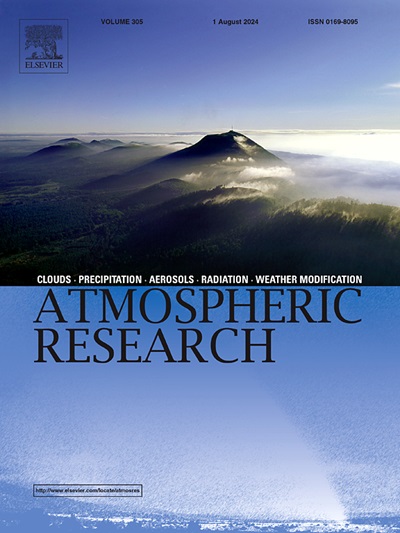CMIP6模式中北大西洋热带气旋发生频率的模式间传播
IF 4.5
2区 地球科学
Q1 METEOROLOGY & ATMOSPHERIC SCIENCES
引用次数: 0
摘要
北大西洋热带气旋(TC)成因模拟一直是耦合模式面临的挑战,它显示出北大西洋主要发展区热带气旋数量及其与北半球总量之比在模式间的显著差异。这一比例被称为相对热带气旋生成频率(RTCGF)。通过从 30 个耦合模式相互比较项目第六阶段(CMIP6)模式的历史模拟中明确探测热带气旋,我们发现相对热带气旋生成频率从 0.2 % 到 18.9 % 不等,而观测数据为 14.8 %。不同模式的 RTCGF 差异主要受大尺度条件和非洲东风波的影响,而模式分辨率的影响有限。大尺度条件的差异源于北大西洋与热带地区的相对海面温度(SST)。较高的相对海面温度会引发来自太平洋的西风和来自非洲的东风向北大西洋辐合,从而增强低对流层涡度、中对流层上升运动和湿对流,为热带气旋的生成创造更有利的大尺度条件。然而,垂直风切变受相对海温的影响较小,在TC成因的模式间传播中作用不大。进一步的分析表明,在目前的耦合模式中,水平分辨率并不是准确模拟相对 SST 和非洲东风浪活动的关键。我们的研究结果表明,在分辨率约为 1-2° 的耦合模式中,模式物理可能与 TC 活动更相关。本文章由计算机程序翻译,如有差异,请以英文原文为准。
On the inter-model spread of tropical cyclone genesis frequency over the North Atlantic in CMIP6 models
The simulation of tropical cyclone (TC) genesis in the North Atlantic (NA) has long posed a challenge for coupled models, showing significant inter-model spread of TC numbers in the NA main development region and its ratio to the Northern Hemisphere total. This ratio is referred to as relative tropical cyclone genesis frequency (RTCGF). By explicitly detecting TCs from the historical simulations of 30 Coupled Model Intercomparison Project Phase 6 (CMIP6) models, we found that the RTCGF ranges from 0.2 % to 18.9 %, compared to 14.8 % in the observations. This diversity in RTCGF across models is mainly affected by large-scale conditions and African easterly waves, whereas the impact from model resolution is limited. The differences in large-scale conditions originate from the relative sea surface temperature (SST) in the NA compared to the tropics. A higher relative SST triggers the convergence of westerly from the Pacific Ocean and easterly from Africa toward the NA, which enhances low-troposphere vorticity, mid-troposphere ascending motion, and moist convection, creating more favorable large-scale conditions for TC genesis. However, vertical wind shear is less affected by relative SST and has a minor role in the inter-model spread of TC genesis. Further analysis demonstrates that the horizontal resolution is not the key for accurately simulating relative SST and the activity of African easterly waves in the current coupled models. Our findings suggest that model physics may be more relevant to TC activity in coupled models with a resolution of approximately 1–2°.
求助全文
通过发布文献求助,成功后即可免费获取论文全文。
去求助
来源期刊

Atmospheric Research
地学-气象与大气科学
CiteScore
9.40
自引率
10.90%
发文量
460
审稿时长
47 days
期刊介绍:
The journal publishes scientific papers (research papers, review articles, letters and notes) dealing with the part of the atmosphere where meteorological events occur. Attention is given to all processes extending from the earth surface to the tropopause, but special emphasis continues to be devoted to the physics of clouds, mesoscale meteorology and air pollution, i.e. atmospheric aerosols; microphysical processes; cloud dynamics and thermodynamics; numerical simulation, climatology, climate change and weather modification.
 求助内容:
求助内容: 应助结果提醒方式:
应助结果提醒方式:


